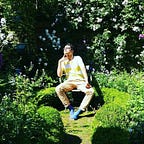Why can’t we take art to where the people are? Karoliina Niemelä from OAMK in Oulu shares highlights from a unique experiment in the heart of the Finnish city.
The push to digitise cultural heritage needs to be accompanied by bold ideas to engage audiences offline. As this experiment from Oulu demonstrates, inspiration can come from unexpected spaces in a city. This activity is part of smARTplaces, a visionary audience development project co-funded by the Creative Europe Programme of the European Union.
The Collection is an archive of 300 photographs and comic strips from artists across northern Finland. The artworks are currently displayed in the corridors of the Oulu University of Applied Sciences (OAMK). In the spring of 2017, as the first step to raise awareness of The Collection, the team launched a website. Later that year, they conducted their first audience engagement experiment — a pop-up exhibition in the heart of the city. This is a conversation with Karoliina Niemelä who, along with her colleague Jussi Kangasoja, devised and ran the experiment using the Digital Identities framework.
“The desire to bring life back into these streets was a big motivation for organising a pop-up exhibition in the city centre.”
Hi Karoliina, what inspired you to run a pop-up in the city-centre?
Over the last four years, Oulu has gone through a period of intense development and we’ve ended up with a glut of shopping malls. One unexpected outcome, or perhaps a natural conclusion is that the shops that were once dotted across the city, have been swallowed up by these malls, creating ghost streets. The desire to bring life back into these streets was a big motivation for organising a pop-up exhibition in the city-centre. We also wanted to take The Collection to the people of Oulu, rather than wait for them to come to us.
How did you develop the concept for the pop-up?
To complement our digitisation efforts, we decided to project images onto the shop windows rather than exhibit the physical collection. This helped us keep the production costs low. We selected images that have been water damaged — Stefan Bremer’s dance themed photographs, so it was a real opportunity to show work that the public can no longer access.
The presentation was simple, but I feel it was quite effective — four projectors, one for each window, set to a different rhythm. We had an additional screen with information about The Collection.
As for the location, I believe we found the perfect spot — opposite the City Hall. We were offered this empty shop at no cost by an insurance company. In return, we included their logo in the projections.
“Even before we began the project… we had created a feeling that it was going to be an enormous undertaking.”
What was the biggest challenge you faced?
If I am to be honest, it was our mindset. Everyone is so busy, there’s little room to try new ideas out. Any task, no matter how small, can seem like a challenge. As a result, even before we began the project, we had created a feeling that it was going to be an enormous undertaking. In reality, it was just a case of breaking the idea down into a series of logical steps. We also invited collaboration to bring the idea to life.
“Collaboration wasn’t a case of throwing open the doors and asking anyone to do whatever they can to help.”
What kind of collaborative relationships did you set up?
Collaboration wasn’t a case of throwing open the doors and asking anyone to do whatever they can to help. We would have had no time to manage all these relationships. Once we had identified our strengths, we reached out to different groups with a specific request. This clarity created a lot of good will. Everyone was supportive and we ended up working at a much faster pace than what we had anticipated. We also collaborated with LUMO to run the pop-up during the 10-day light festival. Last year the festival attracted nearly 86,000 people to the city. It was a fantastic opportunity to test our idea.
“With this experiment we’ve built a foundation for bigger, more ambitious projects.”
What has this experiment helped you achieve?
The importance of recognising the strengths of your team. The exhibition has received a lot of positive feedback and it has created permission internally for us to focus on important questions — how do we increase access to the physical collection? Can we continue to explore new spaces to this present The Collection to the public?
What are your plans for The Collection?
We want to explore variations of the pop-up, as this format is conducive to our mission to make The Collection accessible. Why can’t we take art to where the people are? We also enjoyed the multidisciplinary nature of our collaboration and this is something we want to develop further.
—
This experiment is part of the smARTplaces.eu project, a visionary, long-term European audience development project co-funded by the Creative Europe Programme of the European Union. With 8 cultural institutions, 2 research partners and nearly 60 activities, the project aims to revolutionise the way culture and art can be consumed using digital technology. The first international conference takes place at the ZKM Centre for Art and Media in March. More information available here. You can find out more about The Collection here.
